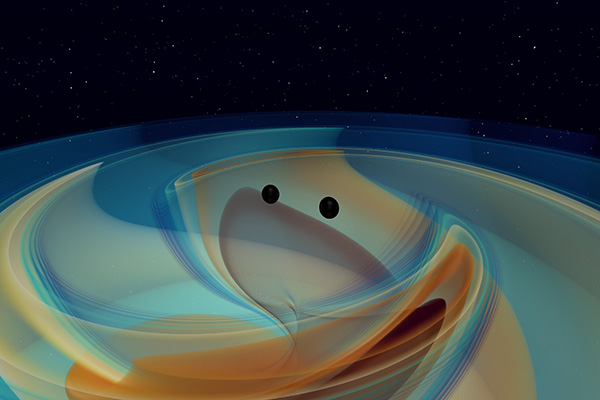Gravitational-wave astronomers have detected the collision of two beefy black holes, which created the most massive merger-made black hole found thus far.
The event, GW231123, rippled through the two detectors of the Laser Interferometer Gravitational-Wave Observatory (LIGO) on November 23, 2023, during the first part of the facility’s fourth observing run. The signal was brief but loud, the cosmic equivalent of a thunderclap.
The event peaked around 60 Hz, near the lower end of LIGO’s reach. Lower frequencies correspond to higher masses — in this case, between 120 and 159 Suns for the larger black hole, 51 to 123 Suns for the smaller one. (The favored values are 137 and 103, respectively.) They joined to make a black hole of approximately 225 solar masses.
The merging black holes appear to have been spinning rapidly, too, at roughly 90% and 80% their maximum velocities, respectively. Researchers presented the results at a joint meeting of the International Conference on General Relativity and Gravitation and the Edoardo Amaldi Conference on Gravitational Waves in Glasglow, Scotland.
The high spins are one of the reasons the mass estimates are so wide. Although the templates scientists use to interpret gravitational waves’ wiggles are reliable for events involving high masses, they struggle with high spins, says team member Sophie Bini (Caltech). There’s thus lots of uncertainty in this smashup’s details.
Both the masses and spins are eye-catching. Due to vagaries in the final moments of massive stars, supernovae shouldn’t be able to make black holes with masses between roughly 60 and 130 Suns. Adjustments to things like nuclear reaction rates, however, could substantially narrow this gap.
It’s possible that GW231123’s two black holes lay on either side of the mass gap, like bookends on the void. Or one or both lay within it. Scientists don’t know.
Most merging black holes detected so far have had negligible spins, consistent with expectations for objects made by exploding stars. Black holes made by mergers, meanwhile, have spins that cluster around 70% their max velocity.
Given the uncertainty ranges, the spins of both of GW231123’s black holes overlap with this benchmark, leaving open the possibility that they’re the offspring of previous collisions. The same goes for the previous mass record-holder, GW190521, which produced a black hole of roughly 140 Suns.
Both of these events spent only a fraction of a second in LIGO’s sensitivity range, though, making it difficult to determine the black holes’ true spins, Bini cautions. Astronomers will need more such events in order to have a better handle on how such objects might form.
When rapidly spinning black holes merge, the recoil will send the remnant rocketing away. In GW231123’s case, the researchers estimate that the recoil velocity might have been some 1,000 km/s, or twice what the Sun would need to escape the Milky Way.
Scientists with LIGO in the U.S., Virgo in Europe, and KAGRA in Japan (united as the LVK Collaboration) have worked together to collectively observe more than 200 black hole mergers during the fourth observing run thus far, and about 300 in total since LIGO’s first observing run in 2015. The team plans to release more results later this summer.
Simona J. Miller / Caltech
Reference:
The LIGO Scientific Collaboration, the Virgo Collaboration, and the KAGRA Collaboration. “GW231123: A Binary Black Hole Merger with Total Mass 190-265 Msun.” Posted to arXiv.org July 10, 2025.

